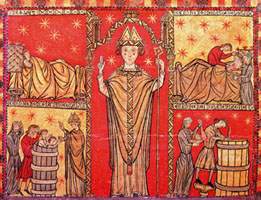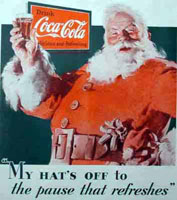A Few Reflections on Christmas
by Izzy Moskovitz
December 16, 2010
What really makes me jolly about Christmas? Being on vacation for a couple of days, now that's what really makes me jolly. For me, that's what the Christmas spirit is all about, laying around the house and eating a lot of yummy food that it bad for you, watching a bunch of television and maybe putting on a couple of DVDs. You've got the traditional cast of holiday superstars, such as Santa, Frosty, Rudolph, and a bunch of busy elves. Oh, yeah, and the baby Jesus. Don't want to forget about him -- seriously. After all, he is the reason for the season, as the saying goes.
Let's take a somewhat detailed look at the phenomenon known as Christmas.
Nobody knows when Jesus was really born. The Bible seems to suggest that it was early in the spring, maybe in late March or early April, which I guess would make the Lord an Aries. Think about it, folks. Jesus really might have been an Aries. He was a daring and radical pioneer, which are characteristics associated with the sign of Aries.
However, notice that it is commonly assumed that he was born on December 25, which would make him a Capricorn, the birth sign of Elvis Presley, in case you didn't know. That would also be alright in my book. Although to be honest, I don't see all that many similarities between Jesus and Elvis. As you know, one died on the cross, and the other died on the toilet. One died for our sins, the other died on a binge -- so much for astrology.
There was a time when our pagan ancestors in Europe -- assuming that "we" are of Caucasian background, which "we" of course may not be -- were into worshipping the sun. In the fall, the days got shorter and shorter, and those ancestors got to thinking that they'd better sacrifice some livestock so that the sun god would come back, or so that the earth wouldn't eat the sun. They thought that unless they took special measures, the days would just keep getting shorter until there just wasn't any sunlight left, and then they'd all wander around in darkness forever. Halfway across the globe, the Aztec people were afraid of the same thing, and took similar measures.
Around the end of December, when, lo and behold, the days started to get longer again with the passing of the winter solstice, they had a big celebration with lots of drinking, fist fights, drinking, hanky-panky, drinking, loud singing, drinking, and huge bonfires. As far as I know, no presents were involved at that time. It was an opportunity to kick back, put on a headdress made of deer antlers, sacrifice a pig upon an altar stone, and just basically blow off some steam and party. Not surprisingly, everyone looked forward to it every year and it became a deeply ingrained custom among those peoples in those days.
Then, a couple of hundred years after Christ, a bunch of monks headed up into the darker regions of Europe to spread the gospel. They found the people there engaged in their usual winter solstice celebrations, and had a big eureka moment.
They thought: "Why fight this? Why try to get these people to give up their winter festival? We certainly won't win them over by doing that. So, what we'll do is tell them that their new savior, Jesus, just so happened to be born on the winter solstice. That way, they can carry on with their usual celebrations, but they'll have to worship the son instead of the sun." It's curious that Christians these days have a few sayings that play on the homonymic relationship between "son" and "sun." I wonder if that kind of wordplay dates all the way back to the first Christmas celebrations in England.
By all this, I don't mean to fault the Christian leaders who assigned Christmas to December 25. The truth is that the Bible doesn't specify the exact date of Christ's birthday, so it is entirely possible that he was born any given day of the year. Given that fact, I figure that it's just as well that Christmas is when it is.
Quite frankly, if there was nothing to celebrate at the end of December, which in terms of daylight length is one of the darkest times of the year, it would be an even harder time to get through than it already is. I think that a lot of people mistakenly attribute their early winter depression to the Christmas culture itself, when in reality science has shown that the reduced daylight hours are to blame -- this is called seasonal affective disorder. So, what better time to remember the birth of Christ than when you most need an emotional boost? But as if celebrating his birthday in and of itself wasn't enough, we've also adopted other heartwarming traditions associated with the holiday season.
In the 1930s in the United States, Coca-Cola got the bright idea of putting the image of Santa Claus on their advertisements. Other American companies imitated this example, and he became even more familiar as a traditional holiday season figure. However, Coca-Cola did not invent him, since there was actually a real historical Santa Claus, otherwise known as Saint Nicholas, whose presence in the United States as a cultural and religious icon dates back to colonial times, who lived during the third and fourth centuries after Christ, and who did some nice things for children and the poor. The Catholic Church had him canonized as a saint, and in the ensuing centuries his memory was kept alive in various ways. I might explain at length the rather interesting, complex, and long history, leading up to the twentieth century, of Saint Nick/Santa Claus as a key component of the holiday season, but for the sake of brevity I will instead leave it up to you, dear reader, to explore that topic on your own elsewhere.


A thirteen century depiction of Saint Nicholas
and his cousin Santa from a 1931 magazine ad.
Coca-Cola probably figured, we want to sell more during the Christmas season, but we can't do it by putting the face of Jesus Christ on our advertisements. I mean, people would draw the line with that, because they don't want to think of their lord and savior as an agent for retail sales. But on the other hand, customers want a friendly face that they can associate with a product they are going to buy. Who else might represent the spirit of Christmas? So, taking their cue from popular illustrators of the day such as Norman Rockwell and N.C. Wyeth, they decided to give Saint Nicholas a try. Thus began the widely popularized standard modern version of the jolly fellow that we know as Santa Claus.
In children's cartoons and movies, he is the embodiment of holiday happiness and cheerful compassion. He has magic powers that he uses with great care and wisdom. He's always ready to surprise a sad and impoverished little child with an extra-special holiday gift. He's funny, daring, loyal, smart, clever, and humble as well. In summary, Santa Claus personifies Christmas benevolence and joy.
Here are some things that almost everyone in the United States knows about Santa Claus:
He lives at the North Pole and has a toy factory run by elves. He comes into your home with a bag of toys that he places under your Christmas tree. So, if you don't like what your parents got you for Christmas, they could say that Santa brought them, which can get Mom and Dad off the hook. He has a sleigh that is pulled by reindeer wearing jingly bells, and they can fly through the sky. Santa lands on top of the roof to go down the chimney. He travels all over the world in one evening, giving his toys to children everywhere. He is married to Mrs. Claus, who supports him in his altruistic Christmas activities. To my knowledge, they are childless. As a little boy, I was under the impression that Santa Claus was still alive. I assume that many kids today also think this.
I am not exactly sure how much those descriptions literally correspond to the historical accounts of Saint Nicholas, but do I think it safe to say that the spirit of generosity and kindness to children that characterized him are abundantly evident in his modern-day manifestation.
Unlike Saint Nick, other holiday figures have much more recent origins. For example, let's consider Rudolph the Red-Nosed Reindeer, a character that has added an interesting new twist to the Santa phenomenon. It all started in 1939 as part of a promotional campaign for a department store, really took off with a catchy song that we still sing today, and was then dramatized by animators for children's Christmas movies.
Another important contemporary Christmas personage is Frosty the Snowman, who was invented in 1950. Similar to Rudolph, he captured the public's attention in a big way with a memorable little tune that introduced a new character who would appear in subsequent holiday films. Actually, the relationship between Frosty and Christmas is only incidental at best. Check out the lyrics to the Frosty song, which makes no direct mention of Christmas whatsoever. Still, after awhile everyone started to think of Santa, Rudolph, and Frosty as one complete holiday package.
For me, Christmas is all about putting up a bunch of flashing multi-colored lights, decorating a green plastic tree, buying presents for family and friends, singing about Frosty the Snowman, eating too many sweets, gaining ten to twenty pounds during a two-week period, taking some time off work in order to get in closer touch with my family and friends, watching those old classic holiday movies and shows and listening to those traditional holiday songs, and finally -- and most importantly -- for me, Christmas is about remembering Jesus Christ and trying to be more Christ-like in all that I do.
Merry Christmas, dear reader!
Copyright 2010 by Somebody's Webpage




